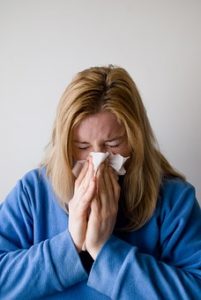The following was written by Dr. Kelly Cawcutt and originally posted to the Physician’s Weekly Blog on May 31, 2018. Dr. Cawcutt was inspired by a recent personal experience with an upper respiratory infection and its impact on her senses of smell and taste, and she shares how some infections can interfere with basic senses we often take for granted.
******
It all started with allergies – or so I thought. We moved into a new house and there are all of these new plants, some more exotic, that were in full bloom when it started. The itchy watery eyes, the sneezes, the post-nasal drip..drip..drip. Too much? Nah, you hear (and see) worse over your Grand Rounds or Noon Lunch-and-Learn sessions.
But, I digress.
 Then it got worse. Around 1 week later, the cough started. The body aches. The headaches. The sore throat. The “influenza-like illness,” or ILI, arrived with no apologies. I thought the virus had done its worst; then, as I made my morning coffee, Wacky Wednesday started. I could not smell it. It seemed strange, but I thought it was just congestion. I took a sip. Hot liquid, tasteless. I rummaged through my kitchen–smelling and tasting noxious things, testing my senses. Garlic? Nothing. Chili Lime seasoning? Nothing. Pepper, salt, ginger? All nothing.
Then it got worse. Around 1 week later, the cough started. The body aches. The headaches. The sore throat. The “influenza-like illness,” or ILI, arrived with no apologies. I thought the virus had done its worst; then, as I made my morning coffee, Wacky Wednesday started. I could not smell it. It seemed strange, but I thought it was just congestion. I took a sip. Hot liquid, tasteless. I rummaged through my kitchen–smelling and tasting noxious things, testing my senses. Garlic? Nothing. Chili Lime seasoning? Nothing. Pepper, salt, ginger? All nothing.
I lost my sense of taste and smell.
The loss of smell (anosmia) and taste (ageusia) impact millions of adults in the United States, with distortions in smell being more common. The actual prevalence is likely underestimated, however, given that the primary method of diagnosis is self-reporting. The range of symptoms can go from impairment to total absence and to phantom sensory involvement—that’s right, smelling the roses when they are not there. Advanced age can be a cause for loss of both of these chemosensory agents, but there are many other potential causes, including sinus disease, ear diseases, trauma, neurologic diseases, and infections ranging from the sinuses to the oral cavity to upper respiratory infections and beyond. Interestingly, hepatitis C is also associated with altered perceptions of taste.
Of course, as an ID specialist, the infections are what catch my eye.
What infections can cause this? How does it happen?
Loss of smell from infection, or any kind of sinusitis, usually is due to the acute inflammation of the nose and sinuses impeding the olfactory nerves and system to respond appropriately.
 For most infections, think the common cold or upper respiratory infections, it seems that the post-infection loss of smell is generally temporary due to the phenomenal plasticity of the olfactory system. In fact, after URI’s, 32-66% of patients will recover their sense of smell spontaneously. For those struggling, training your sniffer can carry significant advantages toward recovering with intentionally smelling various types of odors a few times per day to “retrain” the olfactory system. It’s physical therapy for the nose!
For most infections, think the common cold or upper respiratory infections, it seems that the post-infection loss of smell is generally temporary due to the phenomenal plasticity of the olfactory system. In fact, after URI’s, 32-66% of patients will recover their sense of smell spontaneously. For those struggling, training your sniffer can carry significant advantages toward recovering with intentionally smelling various types of odors a few times per day to “retrain” the olfactory system. It’s physical therapy for the nose!
Taste carries similar risk factors, with URIs, oral infections, sinus infection,s and the unusual association of hepatitis with ageusia. Dysgeusia is more common that ageusia, and many of those who have alternations in taste will also report changes in their sense of smell. Pathophysiology is very similar—acute inflammation of the immediate nerves enroute back to the brain limit the sensation. Except with hepatitis C—there are several potential hypotheses out there on this one, but it is thought that the virus directly impacts the nervous system, resulting in symptoms.
All this being said, smell and taste can be a secondary impact of many common viral and bacterial infections of the head and neck. Treatment should be specific toward the underlying infection to start. Any infections that can cause mass or invasive lesions (aspergillus, mucormycosis, actinomyces) could also result in damage. Many patients will have full recovery, but for those who do not, referral to a specialist is in order for further evaluation and management.
As for me, my taste and smell started to recover slowly after about 48 hours. But, it did raise some awareness—without smell, I may miss the smell of my roses, but I would also not smell the smoke from a fire spreading outside or a gas leak from my stove. These are tangible risks that we should consider in patients with reported losses.
Tomorrow, I will try again to stop and smell the roses.
References
https://academic.oup.com/chemse/article/41/1/69/2365821
https://academic.oup.com/chemse/article/42/7/513/3844730
https://www.ncbi.nlm.nih.gov/books/NBK482152/
https://www.amjmed.com/article/S0002-9343(16)30177-2/fulltext
